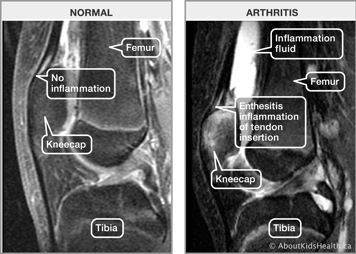Magnetic resonance imaging (MRI) is another type of imaging. The MRI machine uses a magnet, radio signals, and a computer to scan and produce images of the body. Each image shows a different “slice” or level of the body. A doctor called a radiologist reads these images or scans.

Does an MRI hurt?
An MRI scan is fairly noisy but does not hurt. If your child is able to lie still for an hour then usually no medication will be given. If, however, they have trouble lying still for that time, perhaps because their joints are hurting, a medicine can be given to help them relax or sleep. This medicine is given either by mouth or through an IV.
How is an MRI done?
Before starting the MRI, your child will change into a hospital gown. Then they will lie on a bed in front of the MRI machine.
The MRI scanner is a large square machine with a deep, wide tunnel in the centre. When everything is ready, including any sedation if necessary, the bed will be moved into the tunnel. All of your child's body will be inside the tunnel. The MRI scanner makes a loud knocking or drumming sound during scanning. However, they will be able to speak with the radiologist through a speaker. Some people find being inside the tunnel of the MRI a little frightening—the MRI can be stopped if this is too difficult for your child. However, if the scan is stopped, only some of the information will be available to the doctors.
Some MRI scans give the doctor more information when they are done with a liquid called contrast medium. If this is necessary, the contrast medium will be given to your child through an IV tube placed in your vein.
Unless your child is receiving a general anaesthetic (medication to make them sleep so they don’t move), you or another family member will be able to stay with your child in the room throughout their MRI. There might also be a nurse and anaesthetist in the room with them.
Once the MRI is done, the radiologist will review it. The radiologist will send a report to your child's doctor to be reviewed. Your child's doctor will discuss the results of the study with you and your child at a follow-up appointment.
